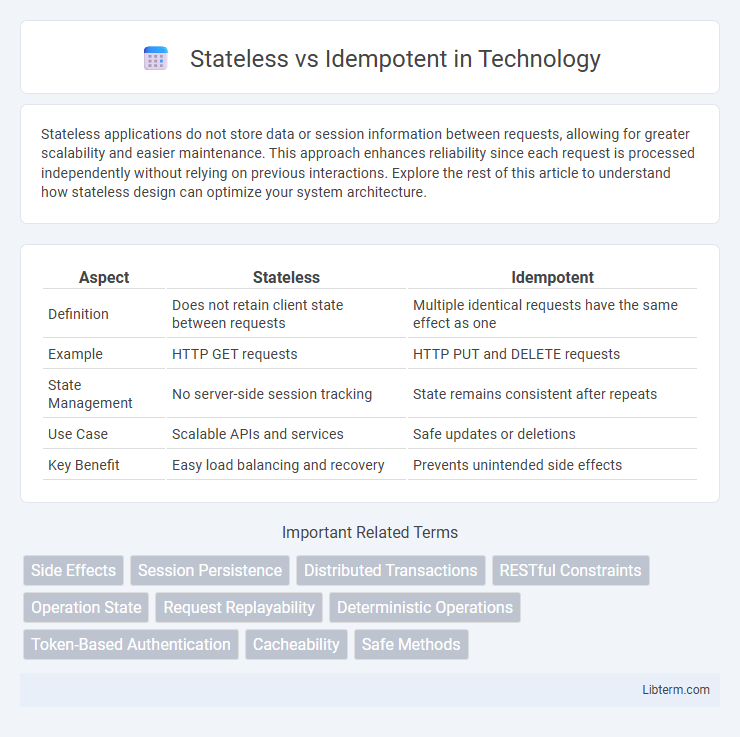Stateless applications do not store data or session information between requests, allowing for greater scalability and easier maintenance. This approach enhances reliability since each request is processed independently without relying on previous interactions. Explore the rest of this article to understand how stateless design can optimize your system architecture.
Table of Comparison
| Aspect | Stateless | Idempotent |
|---|---|---|
| Definition | Does not retain client state between requests | Multiple identical requests have the same effect as one |
| Example | HTTP GET requests | HTTP PUT and DELETE requests |
| State Management | No server-side session tracking | State remains consistent after repeats |
| Use Case | Scalable APIs and services | Safe updates or deletions |
| Key Benefit | Easy load balancing and recovery | Prevents unintended side effects |
Understanding Statelessness in Computing
Statelessness in computing refers to systems where each request from a client is treated as an independent transaction, without relying on previous interactions or stored session data. This architecture simplifies scalability and fault tolerance by eliminating the need for the server to retain user context, enabling easy distribution across multiple servers. Understanding statelessness is crucial for designing RESTful APIs and cloud-native services that maintain consistency and performance without server-side session management.
What Does Idempotent Mean in Technology?
Idempotent in technology refers to an operation that can be performed multiple times without changing the result beyond the initial application, ensuring consistency and reliability in system behavior. Unlike stateless operations that do not retain any session information, idempotent actions guarantee the same outcome even if the operation is repeated due to retries or failures. This property is critical in RESTful APIs and distributed systems to avoid unintended side effects and maintain data integrity.
Key Differences Between Stateless and Idempotent
Stateless operations do not retain any client context between requests, ensuring each request is independent and self-contained, whereas idempotent operations guarantee the same result regardless of how many times the request is executed. Statelessness pertains to the server's lack of session information, while idempotency specifically concerns the effect of repeated requests on resource state. Key differences include statelessness focusing on server design for scalability and reliability, while idempotency ensures safe retries without unintended side effects.
Real-World Examples of Stateless Systems
Stateless systems, such as HTTP web servers, handle each request independently without storing client session information between interactions, enabling scalability and fault tolerance. APIs like RESTful services illustrate idempotent operations where multiple identical requests yield the same result without side effects, exemplified by HTTP methods GET and PUT. Examples include Amazon S3 storage where uploading the same file repeatedly remains consistent and DNS queries where responses do not depend on prior requests.
Common Use Cases for Idempotent Operations
Idempotent operations are essential in APIs and web services, enabling safe retries without unintended side effects, such as repeated payment transactions or updating user profile information consistently. Stateless designs complement these operations by ensuring each request contains all necessary information, enhancing scalability and reliability. Common use cases for idempotent operations include HTTP methods like GET, PUT, and DELETE where repeated requests produce the same outcome, avoiding duplication or data corruption.
Pros and Cons of Stateless Architectures
Stateless architectures enhance scalability and fault tolerance by eliminating server-side session storage, allowing each request to be processed independently and reducing resource consumption. However, they can increase client complexity, as state must be managed externally, and may necessitate repeated data transfer, impacting bandwidth efficiency. Despite these challenges, stateless systems simplify load balancing and improve resilience by avoiding session-related bottlenecks or failures.
Advantages and Limitations of Idempotency
Idempotency ensures that multiple identical requests have the same effect as a single request, preventing unintended side effects and improving reliability in distributed systems. Its primary advantage lies in enabling safe retries without duplicating operations, which is crucial for payment processing, API design, and database transactions. However, idempotency can introduce complexity in implementation, often requiring additional state management or unique request identifiers, and may not be feasible for all operations that inherently produce different results with each execution.
Stateless vs Idempotent in RESTful API Design
Statelessness in RESTful API design means each request from client to server must contain all the information needed to understand and process the request, ensuring the server does not store session state between requests. Idempotent methods, such as GET, PUT, and DELETE, guarantee that multiple identical requests have the same effect as a single request, preventing unintended side effects. Designing APIs with statelessness improves scalability and reliability, while idempotency ensures safe retry mechanisms and robustness in network communication.
Best Practices for Implementing Stateless Services
Implementing stateless services ensures scalability and reliability by treating each request independently without storing client session data on the server, which simplifies load balancing and fault tolerance. Idempotent operations, such as HTTP GET, PUT, and DELETE methods, can be safely retried without causing unintended side effects, making error recovery and consistency easier to manage in distributed systems. Combining stateless design with idempotent operations enhances API robustness, reduces server-side resource consumption, and aligns with RESTful best practices.
When to Choose Stateless or Idempotent Approaches
Choose stateless approaches when designing APIs that require scalability and simplicity, as each request contains all necessary information and no client context is stored server-side. Opt for idempotent methods when operations must be safely repeatable without side effects, ensuring consistent results even if requests are retried due to network failures or client errors. RESTful APIs typically use stateless protocols with idempotent HTTP methods such as GET, PUT, and DELETE to balance efficiency and reliability in distributed systems.
Stateless Infographic

 libterm.com
libterm.com